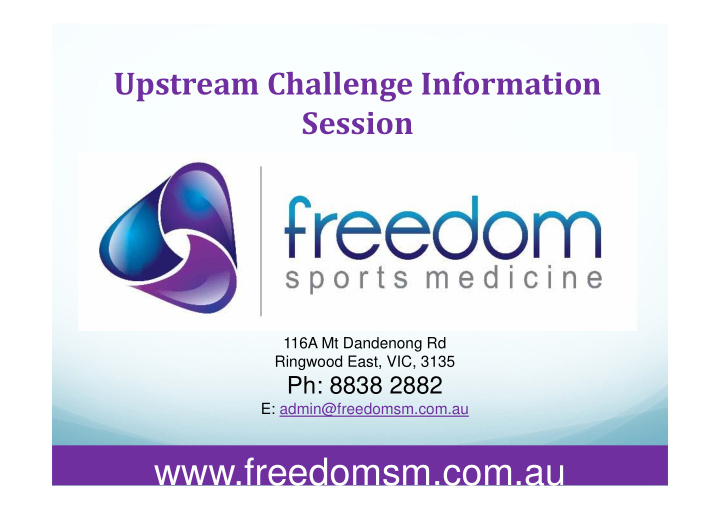



Upstream Challenge Information Session 116A Mt Dandenong Rd Ringwood East, VIC, 3135 Ph: 8838 2882 E: admin@freedomsm.com.au www.freedomsm.com.au
Upstream Challenge 2014 Lauren Starr Bachelor of Science Master of Physiotherapy Physiotherapist Freedom Sports Medicine Injury prevention strategies
Preparation Make sure that your training is graduated Make sure that you practice your fueling strategy prior to the event Wear good shoes that are ideal for you Nothing new happens on the event Self massage/stretching Cross training (Yoga/Pilates/bike/pool)
Preparation Address any niggles/injuries straight away Listen to your body at all times- don't be afraid to go easy or take a recovery day Try to fit in some specific strength training in areas that you need as an individual Core Gluteals Calves Quads/VMO
Key points to stay injury free! Cross train Self massage/stretch Listen to the body Graduated adaptation with your load Rest days Good shoes a must Recovery as important as the training
Self massage tips Gluteals Quads Calves Hip Flexors Sole of your foot Hamstrings
Basic strength exercises Single leg calf raises Double leg bridge – march if possible Leg raises Clams ¼ squats
Any questions? Lauren Starr Physiotherapist Freedom Sports Medicine www.freedomsm.com.au
Footwear & Blister Prevention Caleb McInnes Sports Podiatrist Owner/Director Freedom Sports Medicine caleb@freedomsm.com.au
What is a Podiatrist Trained to assess diagnose and manage problems of the foot and lower limb Foot, shin, calf, knee Sometimes hips and lower back Exercise prescription Dry needling Taping Orthotics Injectiono Techniques Gait Analysis
Incorrect Footwear Injuries are multi ‐ factorial Ill fitting & poorly functioning shoes can contribute to causing injuries Can impede peak performance
Common Issues and Misconceptions Too small Most expensive best....is it...?? Buy bigger to grow into Higher cut means more support Shoes feel hard so people buy softer ones Blisters Don’t need orthotics in a supportive shoe
Choosing the right shoe Not everyone is built the same. Gender differences • Activity specific • Foot structure Biomechanics Length, width & depth Features in every shoe Variety of support & stability features.
Features all shoes should have • Strong heel counter • Laces, buckle strap or Velcro • Flex / bend at the ball of the foot • Stiff Shank • ? Stack Height
Normal Foot Function Pronation: I s the rolling in of the foot when the foot strikes the ground. Normally, the foot will pronate (roll inward) to absorb shock when the heel hits the ground, and to assist in balance during mid ‐ stance. Supination: Supination is the opposite of pronation. It allows the foot to be a more stable, rigid structure for when we push off on our next step. The foot naturally supinates during the toe ‐ off stage (when the heel first lift off the ground until the end of the step) to provide more leverage and to help roll off the toes. RIGHT FOOT
Ankle Joint ROM 10-12+ cm with Lunge to Wall Gastrocnemius & Soleus How we compensate?
Support Structure in Runners Different shoes have different levels of support. Mid Sole density change Last shape - Curved or Straight? Position of Support - Rearfoot, Midfoot or Forefoot?
Length and Width Length • Allow a distance of approx 12mm between longest toe and the end of the shoe. • Always measure length when weight bearing • You shouldn't feel your foot hitting the end of the shoe when walking or running. • Growing Kids - buying shoes the correct length is important. Width • Allow 2 fingers width between the eye-lets of laces. • A shoe should feel firm on the foot but not constrictive. • The foot should not be deforming the shape of the shoe.
Shoe Wear • How long should shoes last for ? • Wear Patterns ? – What is normal • Outside of Heel 1 st Toe •
Multiple Pairs of Shoes • Rotation increases shoes life time • Prevents biomechanical dependence • Builds & helps maintain muscle strength • Not for everyone
Blisters & Prevention • Are a combination of moisture and friction • Caused by I'll fitted or tightened shoes • Support in the incorrect place. • Materials • Socks.
Blister Prevention • Socks (Natural vs Synthetic) – Moisture management – Thickness – Fit • Shoes – correctly fitted and fastened Body Glide, Bepanthenan Gel, Duofilm, Compeed, Allevyn Thin
Any questions? Caleb McInnes Sports Podiatrist Owner/Director Freedom Sports Medicine caleb@freedomsm.com.au www.freedomsm.com.au
Recommend
More recommend